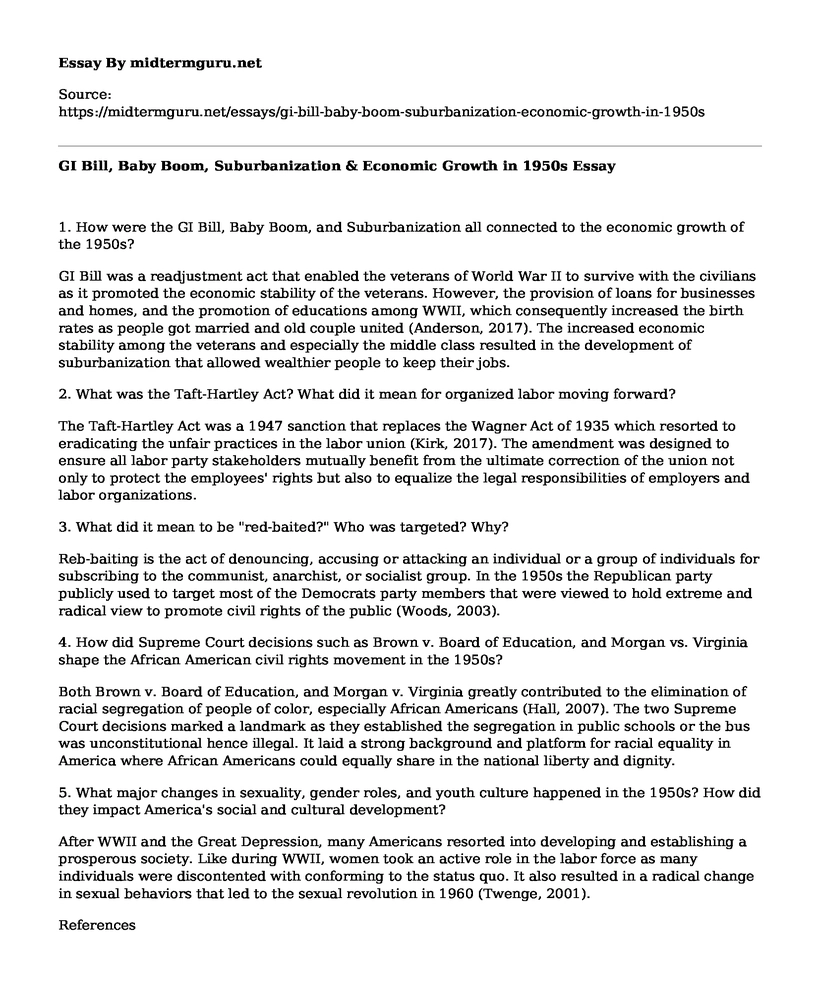1. How were the GI Bill, Baby Boom, and Suburbanization all connected to the economic growth of the 1950s?
GI Bill was a readjustment act that enabled the veterans of World War II to survive with the civilians as it promoted the economic stability of the veterans. However, the provision of loans for businesses and homes, and the promotion of educations among WWII, which consequently increased the birth rates as people got married and old couple united (Anderson, 2017). The increased economic stability among the veterans and especially the middle class resulted in the development of suburbanization that allowed wealthier people to keep their jobs.
2. What was the Taft-Hartley Act? What did it mean for organized labor moving forward?
The Taft-Hartley Act was a 1947 sanction that replaces the Wagner Act of 1935 which resorted to eradicating the unfair practices in the labor union (Kirk, 2017). The amendment was designed to ensure all labor party stakeholders mutually benefit from the ultimate correction of the union not only to protect the employees' rights but also to equalize the legal responsibilities of employers and labor organizations.
3. What did it mean to be "red-baited?" Who was targeted? Why?
Reb-baiting is the act of denouncing, accusing or attacking an individual or a group of individuals for subscribing to the communist, anarchist, or socialist group. In the 1950s the Republican party publicly used to target most of the Democrats party members that were viewed to hold extreme and radical view to promote civil rights of the public (Woods, 2003).
4. How did Supreme Court decisions such as Brown v. Board of Education, and Morgan vs. Virginia shape the African American civil rights movement in the 1950s?
Both Brown v. Board of Education, and Morgan v. Virginia greatly contributed to the elimination of racial segregation of people of color, especially African Americans (Hall, 2007). The two Supreme Court decisions marked a landmark as they established the segregation in public schools or the bus was unconstitutional hence illegal. It laid a strong background and platform for racial equality in America where African Americans could equally share in the national liberty and dignity.
5. What major changes in sexuality, gender roles, and youth culture happened in the 1950s? How did they impact America's social and cultural development?
After WWII and the Great Depression, many Americans resorted into developing and establishing a prosperous society. Like during WWII, women took an active role in the labor force as many individuals were discontented with conforming to the status quo. It also resulted in a radical change in sexual behaviors that led to the sexual revolution in 1960 (Twenge, 2001).
References
Anderson, T. H. (2017). The sixties. Routledge.
Hall, J. D. (2007). The long civil rights movement and the political uses of the past. In The Best American History Essays 2007 (pp. 235-271). Palgrave Macmillan, New York.
Kirk, R. (2017). The political principles of Robert A. Taft. Routledge.
Twenge, J. M. (2001). Changes in women's assertiveness in response to status and roles: A cross-temporal meta-analysis, 1931-1993. Journal of personality and social psychology, 81(1), 133.
Woods, J. R. (2003). Black Struggle, Red Scare: Segregation and Anti-Communism in the South, 1948--1968. LSU Press.
Cite this page
GI Bill, Baby Boom, Suburbanization & Economic Growth in 1950s. (2023, Jan 25). Retrieved from https://midtermguru.com/essays/gi-bill-baby-boom-suburbanization-economic-growth-in-1950s
If you are the original author of this essay and no longer wish to have it published on the midtermguru.com website, please click below to request its removal:
- How Process of Writing History Affects Abina and the Important Men
- Essay on State of Education in High School
- China-USA Trade War Case Analysis
- Research Paper on Muhammad Ali Pasha of Egypt
- Individuals' Attitudes Towards English Usage: Controversial and Non-Controversial - Research Paper
- Article Analysis Essay on "Jefferson and Slavery" and "Jefferson and the Character Issue"
- The Growing Financial Consequences of Conviction: Implications for Reentry - Research Paper







